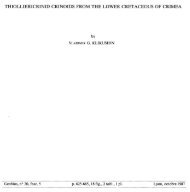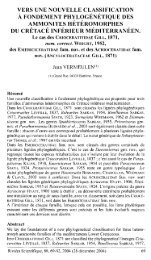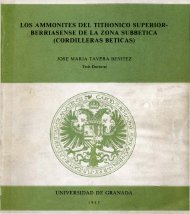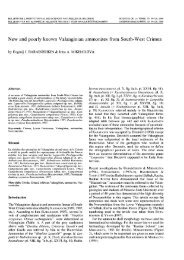peter franklin rawson, dennis curry, frank charles dilley, john michael ...
peter franklin rawson, dennis curry, frank charles dilley, john michael ...
peter franklin rawson, dennis curry, frank charles dilley, john michael ...
You also want an ePaper? Increase the reach of your titles
YUMPU automatically turns print PDFs into web optimized ePapers that Google loves.
from about a million years for the Coniacian to 11 million years for the Campanian.A somewhat different interpretation of the Cretaceous time-scale is now available(van Hinte 1976).4. THE LIMITS OF THE CRETACEOUS SYSTEM(A) The base of the CretaceousAmmonite provincialism had reached such a peak by the end of the Jurassic that itis extremely difficult to correlate the Tethyan and boreal ammonite sequences nearthe Jurassic/Cretaceous boundary. Hence a three-fold stage terminology has evolvedfor the top of the Jurassic: Tithonian for the ‘standard’ Tethyan sequence andVolgian or Portlandian for the boreal regions. Similarly, alternative stage nameshave been used for the lowest stage of the Cretaceous: Berriasian, Infravalanginianand Ryazanian. Casey (e.g. 1962, 1973) and Casey & Rawson (1973b) have urgedthat the stage name Ryazanian (Sazonov 1951) be used for the basal Cretaceousbeds of the Boreal Realm and this is already coming into broader use (e.g. Hancock1972; Surlyk 1973): adoption of this term for those regions where the underlyingJurassic beds are called Volgian provides a consistency of usage and avoids theconfusion caused by the practice (e.g. Saks, editor, 1972) of using a mixed boreal(Volgian) and Tethyan (Berriasian) terminology for the beds spanning theJurassic/Cretaceous boundary. We regard the Volgian/Ryazanian terminology as atemporary measure which should be used until correlation is sufficiently advancedfor an internationally accepted standard for the base of the Cretaceous to beachieved. It appears likely that the base of the Ryazanian is younger than the base ofthe Berriasian as currently delimited in France, and that the Berriasian and Volgianstages overlap. The Jurassic/Cretaceous boundary is thus drawn at a higher level inthe Boreal Realm than in the Tethyan Realm (e.g. Casey 1963, 1973; Hancock1972).Cephalopod faunas of earliest Cretaceous age in the British Isles are boreal, andwe therefore follow the Lexique (Hancock, editor, 1972) in using Ryazanian as thestage term for the earliest Cretaceous rocks of Britain. Here, the base of theCretaceous had long been drawn customarily at a phosphatic nodule horizonmarking the base of the Speeton Clay Formation (Yorkshire), the Spilsby Sandstone(Lincolnshire) and the Sandringham Sands (Norfolk): everywhere this nodule bandrests on Kimmeridge Clay. However, Pavlow (1889) and Casey (1962) recognizedVolgian Craspedites in the Lower Spilsby Sandstone, and the late Jurassic age of thisand of the lower part of the Sandringham Sands is now firmly documented (Casey1973). The Upper Spilsby Sandstone contains Ryazanian ammonites (Casey 1973)and belemnites (Pinckney & Rawson 1974) whilst the occurrence of Hectorocerasprovides a firm Ryazanian date for the Mintlyn Beds of the Sandringham Sands(Casey 1961b, 1973). The earliest ammonites of the Speeton Clay (Neale 1962a;Casey 1973) are Peregrinoceras and allies of late Ryazanian age: they are precededby Acroteuthis of probable Ryazanian age (Pinckney & Rawson 1974).
















